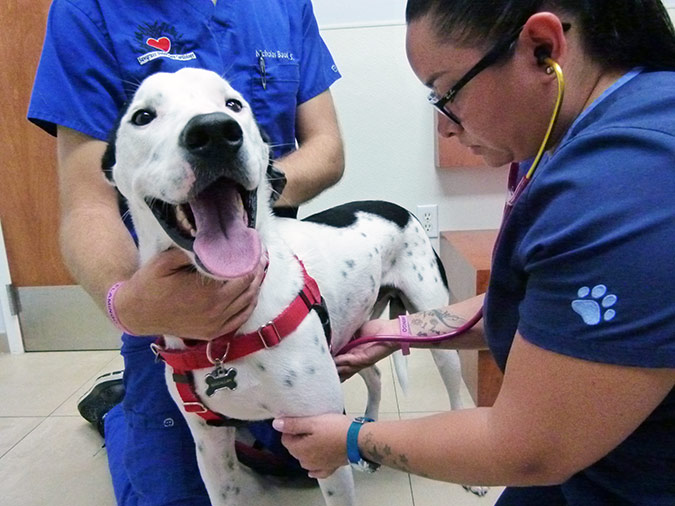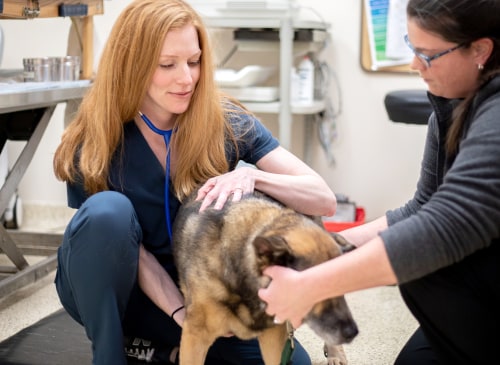Are CT Scans For Dogs Safe? Risks, Benefits, and What to Expect}
Wiki Article
The Role of Ultrasound and CT Check in Modern Veterinary Practices: Insights From Experienced Professionals
In modern-day vet techniques, ultrasound and CT scans significantly enhance analysis capacities. These imaging strategies supply essential insights right into animal wellness, guiding treatment choices. Experienced professionals identify the distinct benefits of each method. Ultrasound offers real-time evaluations, while CT checks supply intricate anatomical information. Recognizing their functions and applications elevates essential inquiries concerning their impact on client end results and the future of veterinary diagnostics. What understandings can be obtained from their incorporated use?Recognizing Ultrasound in Veterinary Medicine
Ultrasound is a vital diagnostic device in veterinary medication, providing a non-invasive method to picture internal frameworks. This imaging technique uses high-frequency sound waves to create real-time pictures of tissues and organs, allowing vets to analyze problems without medical intervention. Typical applications consist of examining the heart, liver, kidneys, and reproductive organs, along with checking pregnancies.The procedure is fairly quick and can be executed in numerous settings, making it an accessible option for veterinarians. Unlike radiography, ultrasound gives comprehensive info concerning soft tissues and blood circulation, which is essential for accurate diagnoses.Veterinary specialists count on ultrasound to discover problems such as tumors, cysts, and fluid build-up. Its capacity to lead biopsies and various other treatments additionally boosts its energy in professional technique. By using a reliable and risk-free method to check out internal anatomy, ultrasound has ended up being a keystone of modern-day veterinary diagnostics.
The Benefits of CT Scans for Pet Diagnostics
CT scans deal substantial advantages in vet diagnostics by providing improved accuracy in determining inner conditions (Ultrasound For Dogs). As a non-invasive imaging strategy, they guarantee the safety and comfort of pets throughout examinations. Furthermore, CT checks promote an extensive evaluation of internal structures, permitting more effective treatment preparationBoosted Analysis Precision
Developments in imaging innovation have actually greatly improved diagnostic accuracy in veterinary medication, particularly via the use of CT scans. These scans supply thorough cross-sectional pictures of an animal's interior structures, allowing vets to determine irregularities with precision. The high resolution and three-dimensional capabilities of CT imaging promote the discovery of conditions such as tumors, cracks, and internal blood loss that may be missed with traditional imaging approaches. In addition, CT scans can help in pre-surgical preparation by supplying a detailed sight of anatomical relationships. This degree of information not only enhances the precision of diagnoses but also help in tailoring efficient treatment strategies. The integration of CT technology right into veterinary methods is changing the landscape of pet healthcare, boosting end results for individuals.Non-Invasive Imaging Method
The intro of non-invasive imaging strategies has reinvented pet diagnostics, with CT checks arising as a popular device in veterinary methods. These scans provide high-resolution, cross-sectional photos of a pet's internal frameworks, allowing vets to evaluate complex conditions without the demand for invasive treatments. The advantages of CT scans include their capability to identify tumors, fractures, and inner blood loss with amazing accuracy. In addition, they facilitate the examination of soft cells and organs, boosting diagnostic capacities. The speed of CT scanning enables fast decision-making, which is essential in emergency scenarios. By decreasing stress and pain for the pet, CT scans add to an extra gentle method to diagnostics, inevitably boosting treatment end results and advancing vet treatment.Comprehensive Internal Assessment
A thorough internal analysis is vital for exact medical diagnosis and reliable therapy in vet medication. CT checks deal significant benefits in this respect, offering thorough cross-sectional pictures of a pet's inner structures. This sophisticated imaging modality enhances visualization of complex physiological regions, enabling veterinarians to identify abnormalities such as growths, fractures, and internal blood loss with greater precision. On top of that, CT scans promote the evaluation of problems that might be testing to detect through conventional techniques. The rate and accuracy of CT imaging also contribute to timely interventions, enhancing person outcomes. As vet methods progressively include CT innovation, the benefits of comprehensive interior evaluations end up being obvious, strengthening the importance of this device in modern-day vet diagnostics.Contrasting Ultrasound and CT Imaging Techniques
While both ultrasound and CT imaging offer important functions in veterinary diagnostics, each strategy supplies distinct advantages and restrictions that can affect medical decision-making. Ultrasound is particularly valued for its real-time imaging capacities, allowing veterinarians to observe dynamic physical procedures. This strategy is non-invasive, mobile, and does not entail ionizing radiation, making it a much safer option for both clinicians and pets. Nevertheless, ultrasound may have limitations in envisioning specific anatomical frameworks or deep tissues.Conversely, CT imaging supplies in-depth cross-sectional sights of the body, enabling specific localization of problems. It masters assessing complex body organs and structures, specifically in the thorax and abdomen. Nevertheless, CT scans need sedation or anesthetic in several cases and include direct exposure to ionizing radiation. Ultimately, the option between ultrasound and CT depends upon the certain clinical scenario, the location of rate of interest, and the necessity of the analysis needs.Case Studies: Effective Diagnoses Via Imaging
Case researches highlight the substantial improvements in analysis precision accomplished via advanced imaging technologies like ultrasound and CT scans in veterinary practices. These advancements not only enhance the detection of numerous problems however likewise promote timely and efficient treatment strategies. Analyzing specific situations can highlight the transformative influence of these imaging techniques on veterinary medication.Analysis Accuracy Improvements

Imaging Innovation Advancements
As veterinary imaging innovation continues to progress, its effect on diagnostic abilities ends up being progressively apparent. Current study highlight the successful application of innovative ultrasound and CT check strategies in determining complicated conditions. A vet center utilized high-resolution CT scans to detect a rare kind of lung cancer in a pet, which traditional imaging had missed out on. An ultrasound examination revealed an abdominal mass in a cat, prompting timely surgical treatment and a positive outcome. These advancements not only enhance diagnostic precision however likewise allow vets to develop targeted treatment strategies. By leveraging advanced imaging technologies, veterinary specialists are noticeably improving client treatment, leading to more efficient monitoring of various wellness conditions in animals.
The Duty of Imaging in Emergency Veterinary Treatment
Imaging plays an essential function in emergency situation vet care, offering vets with vital information needed to make quick, enlightened choices. In immediate situations, methods like ultrasound and CT scans make it possible for specialists to quickly examine an animal's interior frameworks, identifying vital problems such as inner bleeding, cracks, or organ abnormalities. These imaging techniques enable real-time analyses, promoting timely treatments that can be life-saving. For instance, ultrasound is important for assessing soft cells injuries and problems like fluid build-up, while CT scans offer thorough pictures of intricate physiological frameworks, important for identifying trauma situations. The rate and precision of these imaging methods improve the veterinarian's capacity to design efficient treatment plans, ensuring the most effective feasible end results for their individuals. The assimilation of advanced imaging innovations right into emergency situation vet techniques is not just helpful however increasingly necessary, as it enhances diagnostic capabilities and boosts overall pet care during essential moments.
Training and Expertise in Veterinary Imaging
Although sophisticated imaging strategies such as ultrasound and CT scans are essential click here for info for reliable vet care, the effective execution of these modern technologies heavily depends upon the training and proficiency of veterinary specialists. Competent use imaging tools requires extensive expertise of makeup, pathology, and the principles underlying each method. Veterinary experts have to undertake specialized training to precisely interpret imaging results, which is important for detecting conditions and planning treatment.Certifications and proceeding education in vet imaging improve the skills of specialists, allowing them to remain upgraded with technical improvements. Cooperation in between radiologists and veterinarians often results in enhanced diagnostic accuracy, as specialists can provide understandings into complex instances. Additionally, sensible experience in taking care of imaging equipment fosters self-confidence in its application. Eventually, the quality of vet imaging solutions is directly associated to the degree of training and competence had by the professionals using these essential analysis tools.Future Trends in Diagnostic Imaging for Animals
With the fast advancements in innovation, vet analysis imaging is positioned for considerable advancement in the coming years. Emerging trends suggest a change in the direction of more obtainable and portable imaging techniques, such as portable ultrasound tools, which can enhance field diagnostics. Furthermore, the assimilation of expert system is expected to transform picture analysis, enabling quicker and a lot more exact analyses of results.Moreover, advancements in 3D imaging strategies and calculated tomography will provide veterinarians with more comprehensive views of pet makeup, causing better treatment plans. Online truth innovation may additionally play a function in surgical preparation and education, giving veterinarians a distinct viewpoint on intricate cases.As telemedicine proceeds to expand, remote examinations helped with by analysis imaging will certainly end up being extra common, enabling specialists to aid basic professionals in real-time. Overall, these fads are readied to improve the effectiveness and performance of veterinary care, inevitably improving animal outcomes.Frequently Asked Concerns
Just How Much Do Ultrasound and CT Scans Price in Veterinary Clinics?
The expenses of ultrasound and CT scans in veterinary facilities generally range from $300 to $1,500, relying on aspects such as location, center type, and details treatments required for the pet's diagnosis and treatment.
Are There Any Type Of Dangers Connected With Ultrasound and CT Scans for Pet Dogs?
Ultrasound and CT scans generally posture very little threats to pet dogs. Possible concerns include sedation reactions and direct exposure to anesthetics. Vets very carefully evaluate each case to minimize any dangers connected with these analysis proceduresThe Length Of Time Do Ultrasound and CT Treatments Commonly Take?
Ultrasound treatments generally take around half an hour to an hour, relying on the intricacy. CT scans, being more comprehensive, typically require half an hour to 90 mins, including prep work and recuperation time for the animal.Can All Veterinarians Perform Ultrasounds and CT Scans?
Not all veterinarians can perform ultrasounds and CT scans. Specialized training and qualification are commonly required to guarantee competency in these advanced imaging techniques, which may limit their availability to veterinarians with added credentials and sources.What Kinds Of Animals Profit The Majority Of From These Imaging Techniques?
Certain animal types, particularly felines and pets, advantage significantly from ultrasound and CT scans. These imaging methods boost diagnostic accuracy for conditions like lumps, internal injuries, and body organ problems, bring about enhanced therapy outcomes and patient treatment. The high resolution and three-dimensional capacities of CT imaging promote the discovery of problems such as growths, cracks, and interior bleeding that may be missed out on with conventional imaging methods. Case researches illustrate the substantial renovations in analysis accuracy accomplished through innovative imaging innovations like ultrasound and CT scans in veterinary practices. Improving diagnostic precision in vet practices has actually been significantly aided by advancements in imaging modern technologies such as ultrasound and CT scans. Sophisticated imaging techniques such as ultrasound and CT scans are essential for reliable veterinary treatment, the successful implementation of these modern technologies heavily depends on the training and knowledge of veterinary experts. Veterinary professionals must undertake specialized training to precisely analyze imaging results, which is crucial see this here for diagnosing conditions and planning treatment.Certifications and proceeding education and learning in veterinary imaging improve the abilities of specialists, allowing them to stay updated with technological innovations.Report this wiki page